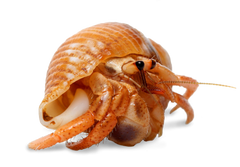Caring for your Hermit Crab
Hermit Crabs are wonderful pets that are easy to look after. The hermit crab has evolved to be able to live on land with the use of empty shells as a home and protection. With the right care, your hermit crab can live up to approximately 15 years. Hermit crabs love company, so have multiple crabs living together. They’ll become more active with the company. Hermit crabs are nocturnal and will sleep throughout most of the day.

Housing
Choose an aquarium with a glass cover for your hermit crabs to live in. As hermit crabs are tropical animals, you’d need to keep the temperature of the aquarium at 30 degrees Celsius, and to not drop below 20 degrees Celsius. Install a low wattage globe above the aquarium, and place a thermometer in the aquarium to keep tabs on the temperature. We advised to heat one end of the aquarium so the hermit crabs can move to where it suits their body temperature best.
It is vital to not fill the aquarium up with water, as the hermit crabs are land crabs. Place either shell grit or aquarium sand over the floor of the aquarium. Try to keep the sand dry at all times. Hermit crabs love to climb, so include driftwood pieces or mangrove roots within the aquarium to provide some entertainment.
Hermit crabs require humidity of around 50-70%. They need this to keep their gills moist and to breathe properly. If the air is too dry, your hermit crab might become inactive and suffocate. To keep a high level of humidity, make sure there’s plenty of water within the water bowls, and the temperature is kept warm and doesn’t become cold.
Two types of water needs to be provided at all times for your hermit crabs. Have fresh water in one bowl for drinking, and in another bowl have sea water for bathing. Sea water can be made up with Hermit Crab Salt and water (follow the measurements on the packet for the correct ratio). Use heavy, solid bowls for the water as hermit crabs love to climb and can tip over the water if a lightweight container is used.
Change water on a daily basis to keep it clean.
Food
Hermit crabs need to be fed daily and in little amounts at a time to ensure the food is fresh. Suitable foods to feed your hermit crab are fish pellets, breads, cereals, apples and other fruits, and shredded coconut. Make sure any food that isn’t eaten that day is removed.
Moulting
Hermit crabs moult their outer skin usually twice a year. When a hermit crab is moulting, you will notice it will become less active, won’t eat, drink excessive amount of water, and may even burrow - this is perfectly normal behaviour during this period. It will take several weeks for the hermit crab’s new skin to harden, so will need to be left alone during this time. The old skins that your hermit crab moults off are usually eaten. Allow them to eat their old skins as this is a rich source of calcium.
Shells
Usually after moulting, hermit crabs will change the shell they the live in. Provide the hermit crabs with some spare shells in the aquarium. It is essential you provide shells that are slightly larger than the previous one as your hermit crabs are continuously growing.
Fighting
Fighting can be an issue if your aquarium is over populated and crowded. You might need to get a larger aquarium if too many crabs live together, and add more climbing ornaments to space the crabs out. Some hermit crabs might get aggressive and pull other crabs out of their shells to steal. It is important to have enough spare shells to avoid this happening.
 Health
Health
Common health problems with hermit crabs include stress and poisoning, so make sure you keep a close eye on them.
Signs of stress include inactiveness, sluggish, and leaving their shells. It is not normal for a hermit crab to walk around or sit in a corner without their shell as they’re exposed and unprotected from other crabs attacking. Stress can be caused from overcrowding and bullying, living alone, being dropped on their shells, or extreme temperatures (either too hot, or too cold).
Hermit crabs can be easily poisoned from cleaning sprays and detergents used around the house, and only a small amount can be fatal. Make sure no chemicals are used when cleaning the aquarium, and none are used near your hermit crabs including hairspray and air fresheners. Be careful if you take your hermit crabs out and place them on carpet, as carpets care normally cleaned with chemicals.
Signs that might indicated your hermit crab is poisoned are dropping their shells off and sitting in water, weakness (they need strong muscles to hold their shell up), and pulling off limbs. As hermit crabs cannot wash toxins off themselves, they will start to pull off affected areas like their legs.
Download our care sheets:
